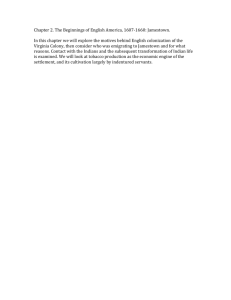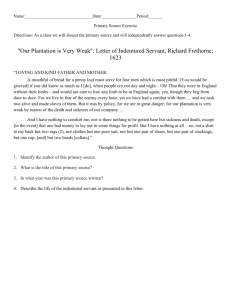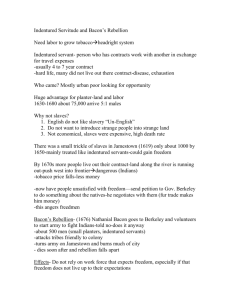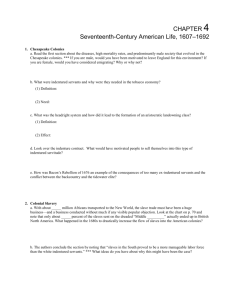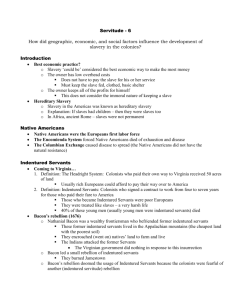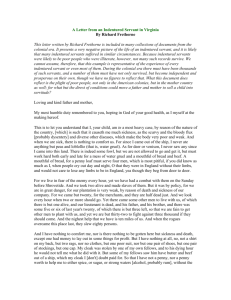Planting Seeds: Tobacco, Ideology, Race
advertisement
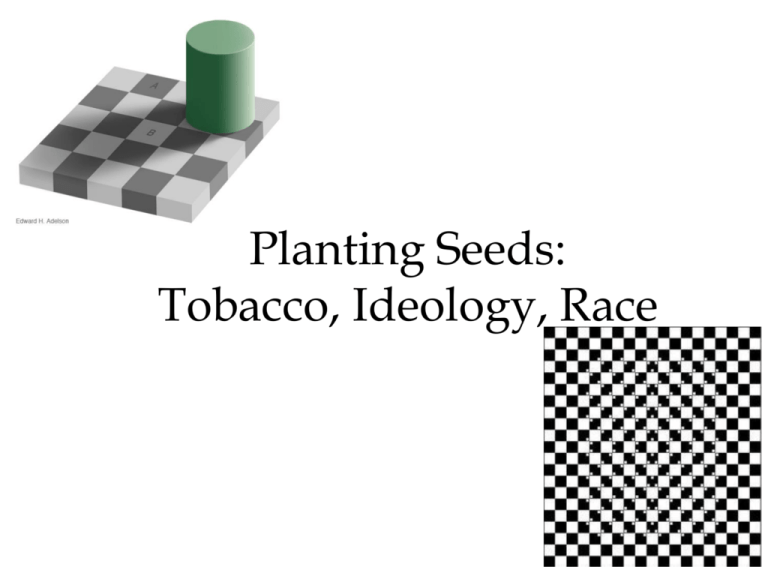
Planting Seeds: Tobacco, Ideology, Race Write a Definition of “Race” Circle each group you think is a race • • • • • • • • • • • • • • African Arab Asian Caucasian Chinese English Greek Hindu Hispanic Iraqi Italian Jewish Mayan Native American Historians’ Definitions of “Race” • "Race is an idea that evolves over time…“ • "Moments in America's past reveal how this idea took hold… “ • "Race was never just a matter of how you look; it's about how people assign meaning to how you look.“ • "America created a story, a story of race." Underline parts of your definition that match the definitions provided by historians. We hold these truths to be selfevident, that all men are created equal • How can a nation proclaim “all men are created equal” and also sanction slavery? • Why was the idea of race needed to reconcile these two principles? 1. List different types of people who inhabited the eastern seaboard of North America in the first half of the 17th century Tuscarora •Example: Native Americans Iroquois Algonquin Cherokee • • • 2. Subdivide each type of people into four subcategories According to historian Robin D. G. Kelley: “Africans came to the New World not as Black people, not as Negroes. They didn't see themselves that way. They saw themselves according to their own sort of ethnic identities. The same was true of Europeans who viewed themselves as Portuguese, or English, or Irish.” -(Interview for RACE - The Power of an Illusion) Larry Adelman, the executive producer of RACE, adds: "It may be hard for us to comprehend today that the American Indians didn't see themselves as Indians. Nor did the English see themselves as white. Neither saw themselves as a race. The peoples of the Americas were divided into separate and distinct nations - hundreds of them. Amerindian nations such as the Algonquians differentiated themselves from the Iroquois or Cherokee by religion, language and customs just as Protestant, English-speaking Britain distinguished itself from Catholic, Spanishspeaking Spain." According to historian Gary Nash: When Jamestown colonist John Rolfe took his new bride, Pocahontas (who had converted to Christianity), back to London in 1616, they caused an uproar among the lords and ladies and dukes and earls of the Court of King James. Not because Rolfe, an Englishman, had married an Indian, but because Pocahontas, a princess, had married a commoner. Why was the marriage of John Rolfe and Pocahontas scandalous? -(Forbidden Love: The Secret History of Mixed Race America. Edge Books. New York:1999) Historian Karen Ordahl Kupperman points out: That, as for physical distinctions, native Americans were most struck by the English colonists' beards and their smell. The colonists wore the same clothes for weeks, were covered with lice, and rarely bathed. The English didn't describe the Indians' color as red in the early days, but rather as tanned or tawny. -(Indians and English: Facing Off in North America. Cornell: 2000) According to historian Ira Berlin: "In Early American society, people distinguish themselves by religion; they distinguish themselves by nationality; they distinguish themselves by family. And however they distinguish themselves, they arrange themselves in a hierarchical order in which a few are on top, and many are on the bottomノ Hierarchy is providential; it's a way that God ordered the world.” -(Interview for RACE - The Power of an Illusion) How did people in 17th century America categorize themselves? What differences mattered the most? Chess Pieces: What Difference Makes a Difference? Draw the shape of your chess piece, without naming it. Now name the chess piece. What characteristics of the piece enabled you to name it? What are the most salient features of the piece? In two or three sentences only, describe the moves this piece can make. In two or three sentences only, describe the advantages this piece offers to the player using it. In relative terms to other chess pieces, how powerful is this chess piece? How else would you describe this chess piece? Directions: Choose 70 colonists distributed among the following occupations to settle a colony in North America. Explain the reasons for your choices in the last column. Occupation council members preachers gentlemen carpenters blacksmiths sailors barbers bricklayers masons drummers boys fuellers refiners gunners perfumers apothecaries surgeons coopers pipe makers tradesmen women tailers laborers Optimal Number Reason Indentured Servitude in Virginia Title of your document(s): Directions: Use only the source material your group has been given to answer as many of the following questions as possible. It is not expected that you will be able to answer all of them. •Who were the indentured servants? For what reason(s) had they come to America? What social class(es) had they occupied in Great Britain? •What was the indentured servant bound by law to provide the master? •What was the master or mistress bound by law to provide the indentured servant? •What rights of indentured servants were curtailed by colonial laws? In what ways did these laws create a second-class citizenry? •What status would the indentured servant occupy upon completion of the contract? What would the master or mistress supply the servant with upon completion of the indentures? •From the point of view of the masters, what problems arose under the system of indentured servitude? Was indentured servitude a reliable form of labor? Why or why not? •What evidence do these documents provide that the laws of Jamestown were beginning to differentiate between European, Indian and African labor? •What evidence do these documents provide that the servant class, whether European, African or Indian, found common ground with each other in their struggles against an oppressive labor system? What types of laws were passed to prevent the union of restless workers from all groups? •From the point of view of the indentured, was the indenture contract a satisfactory insurance of fair treatment in America, and did it offer a reasonable means to eventual success? •In your opinion, who was best served by the system of indenture, the master or the servant? •To make the colony profitable the planters needed an ever-growing source of labor. What were potential points of conflict between the servants and their masters? Defining the Status of an Indentured Servant in Jamestown • Was this person a temporary slave? A full citizen? • What were the distinctions between servant and slave? Jamestown Needs Laborers Available Numbers & Longevity Africans brought as slaves Indians captured in war Indentured Europeans Skills needed for planting & other labors Ability to run away & escape capture Sources of legal, political or military recourse From "Laws on Slavery" –September 17, 1630: The punishment of Hugh Davis –January 1639/40-ACT X: An act creating a legal distinction between white and black men –October 17, 1640-Punishment for a White Man and a Black Woman Who Committed Fornication –March 1655/6-ACT I: An act creating a distinction between Africans and Native Americans –March 1660/1-ACT XXII: An act punishing English servants running away with Negroes –March 1661/2-ACT CII: An act discouraging white indentured servants from running away with enslaved blacks –March 1661/2-ACT CV: An act prohibiting trading among servants and slaves –March 1661/2-ACT CXXXVIII: An act stating that Native American and English servants were to serve their masters the same length of time –March 1661/2: A ruling providing freedom for a Native American slave –December 1662-ACT XII: An act applying the status of the mother on children –September 1663-ACT XVIII: An act prohibiting servants from traveling without a license –September 1667-ACT III: An act declaring that baptism did not alter the status of slaves –September 1668-ACT VII: An act declaring that Negro women were taxable –October 1669-ACT I: An act legalizing the punishment and killing of slaves –October 1670-ACT XII: An act creating further additional distinction between African Americans and Native Americans –September 1672-ACT VIII: An act to suppress the rebellious activities of slaves –June 1676-ACT I: An act declaring Indians captured in war slaves for life [Bacon's Rebellion] –June 1680-ACT X: An act attempting to prevent slave revolts –November 1682-ACT I: An act repealing a former law making Indians and others free –April 1691-ACT XVI: An act attempting to suppress runaway slave communities [The term "white" appears] –April 1692-ACT III: An act stating the procedure for a slave brought to trial for a capital offense –August 1701-ACT II: An act that offered a reward for the apprehension of a notorious runaway slave –October 1705-CHAP. IV: An act that contains the first definition of a mulatto in Virginia's laws –October 1705-CHAP. XXII: An act declaring the Negro, Mulatto, and Indian slaves real estate –October 1705-CHAP. XXIV: An act for settling the Militia –October 1705-CHAP. XLIX: An act that provides a definition of who would become a slave upon entering Virginia Revisionism We usually look at the story of colonial America as a series of steps toward freedom. Is there a different story: that American democracy did not become possible for Americans of European descent until they had enslaved Americans of African descent and justified that action by deeming them a separate and inferior race. Definition of Race The term race or racial group usually refers to the categorization of humans into populations or groups on the basis of various sets of heritable characteristics and self-identification W.E.B. DuBois “for the problem of the Twentieth Century is the problem of the color-line” What is the problem of the 21st Century? 1. What categories were more important than skin color in defining status in early colonial America? 2. Why did the planter class turn to African slavery? 3. What advantages did the enslavement of Africans provide the planter class? 4. What advantages did the enslavement of Africans provide the indentured European class? 5. What role did the law play in creating the permanent enslavement of Africans? 6. As the idea of race evolved, what presumptions were made about American Indians?
